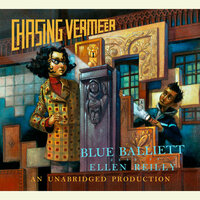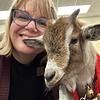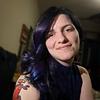Take a photo of a barcode or cover
I get that the point of the book is the possibility of coincidence being more than that, that perhaps there are things in life that we just can't explain (like art speaking to us in dreams), but I just couldn't buy into it. Usually I really enjoy kids lit, but this one I just couldn't do the whole suspension of disbelief thing on. It didn't work for me. We're discussing it in book club this week, so we shall see what the kids thought...
We read this aloud with our 8 year old and we all really enjoyed it. It is an art mystery (stolen painting) set in Hyde Park, Chicago, and the Univ of Chicago Lab School. Two kind of nerdy 6th graders like their quirky teacher and get to be friends and solve the mystery. The pictures are part of the mystery, too. The jacket describes it as a DaVinci Code for kids...I think that fits. Fun read. The kids are 6th graders, and I would recommend for a big reader as young as 2nd grade, up to a reluctant reader in 6th, in my unprofessional parent opinion. I think reluctant readers might like it because it is a mystery and not difficult reading, plus finding clues in the pictures is fun.
I picked this up because of the illustrations - same as ASOUE.
2007 review:
"I love coincidences. I spend a great deal of time getting excited over the smallest patterns and puzzles and similarities of seemingly unrelated events. So I get where this book is coming from, I really do. But in fiction, there is something else I enjoy even more: answers. I love everything to be wrapped up, all the interconnectedness to be explained. In life, this comes across as, well, life, but in fiction, it comes across as laziness. And while I admire the originality of Balliett's debut novel, I still wish it could decide whether it was fantasy or fiction based in a real life world - don't give me a "mystery" and have the "sleuths" solve it through dreams and psychic connections. Books like Holes, and even Time Traveler's Wife, satisfy me far more with their well thought out, carefully crafted puzzles, rather than this novel, marketed as a thriller/mystery for tweens, but which is really more of a(n interesting) meditation on coincidences and patterns, and the meaning of art in our lives. Which is still good, but, you know, not a mystery."
2007 review:
"I love coincidences. I spend a great deal of time getting excited over the smallest patterns and puzzles and similarities of seemingly unrelated events. So I get where this book is coming from, I really do. But in fiction, there is something else I enjoy even more: answers. I love everything to be wrapped up, all the interconnectedness to be explained. In life, this comes across as, well, life, but in fiction, it comes across as laziness. And while I admire the originality of Balliett's debut novel, I still wish it could decide whether it was fantasy or fiction based in a real life world - don't give me a "mystery" and have the "sleuths" solve it through dreams and psychic connections. Books like Holes, and even Time Traveler's Wife, satisfy me far more with their well thought out, carefully crafted puzzles, rather than this novel, marketed as a thriller/mystery for tweens, but which is really more of a(n interesting) meditation on coincidences and patterns, and the meaning of art in our lives. Which is still good, but, you know, not a mystery."
This was an OK suspense book aimed at tweens. The story was an interesting premise, but it was missing a little pizazz. Some parts moved a little too quickly and it was hard to keep up with what was actually happening, creating only a fuzzy image of some portions of the story. It was as if I was reading it in fast forward and missing some parts, but those parts were not there to be found. I did like that it allows the reader to think beyond the typical straight plot lines in most books aimed at tweens. The two primary characters are interesting and I'd be happy to read about more of their adventures.
I tried to read this book quite a time before I really did, but I found it to boring. When I read it again in Year 6 I loved it! The mystery was very exciting and very good!
I really liked it.
I really liked it.
Pretty lame. A few things were well-done, like the sense of mystery, but overall it just wasn't entertaining.
A book I wish I'd read as a child. It reminded me of Robert Anton Wilson, and his focus on "maybe logic." The fact that such a book could exist for children is impeccable. The reality-bending plot-twists and the unexplained leads not only brings back the magic of childhood, but also critical thinking to the forefront of the mind.
This book had potential but I felt like it didn't really go anywhere and I lost interest because of this.
Thought there would be more puzzles to engage with along the way, some point where we would be called into the mystery solving in some way. That didn't really happen. I did appreciate that we had to decipher the code on our own and that the author didn't just instantly translate it. Otherwise, it felt like she dropped a lot of clues that were too random to really fit together. And I never did solve the puzzle in the illustrations. I think it would be too complex for the intended audience. Overall, an interesting premise that gave me new appreciation for Vermeer but otherwise fell flat.






